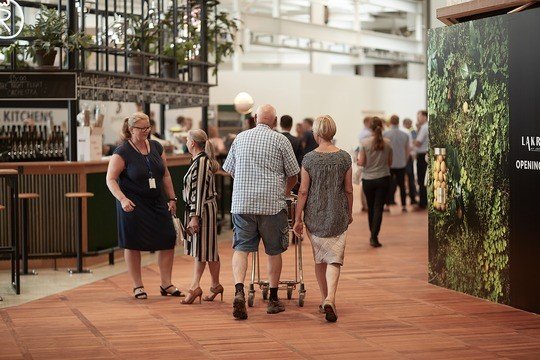Expansion work and new routes make their mark on first half for Copenhagen Airport

14.5 million people travelled through Copenhagen Airport in the first half of 2018, up 3.1% on the same period last year, with the long-haul routes in particular experiencing growth. The airport has also both completed and embarked on several major building projects and will invest approximately DKK 2.0 billion in expanding and improving the airport.
With 14,458,138 passengers in the first half of 2018, Copenhagen Airport set a new record. Compared to the same period in 2017, 3.1% more passengers travelled through the airport. The long-haul, intercontinental routes were the main factor in the increase, with passenger numbers up 9.2% primarily due to new routes.
“Our strategy of expanding the number of long-haul routes is bearing fruit. In the first few months of the year, Cathay Pacific opened a direct route to Hong Kong, Air China to Beijing, and both Norwegian and Royal Jordanian started flying to the Jordanian capital, Amman. There was also capacity expansion on a number of routes, with more already announced in the winter programme. We now have more than 40 direct routes to destinations outside Europe, helping to secure the strong growth in the important area of intercontinental traffic and a core part of our strategy,” says Thomas Woldbye.
He stresses, too, the contribution the summer programme with its 10 completely new destinations made to the airport’s record passenger numbers:
“New direct flights not only give Danish business and leisure travellers more opportunities to head out into the world, but also play a key role in attracting tourists and investors to Denmark. When we open a new route, passenger numbers generally rise, as this makes it easier for tourists in particular to come to Denmark.”
The number of local departing passengers was up 3.8%, while transfer and transit passengers were down 0.4%. The 3.1% increase in total passenger numbers contributed to the 0.5% increase in revenue, while profit before tax, excluding one-off items, was DKK 710.7 million, down 6.2% on the same period in 2017. This was because of the reduction in charges from 1 April 2018, higher depreciation charges and higher staff costs.
New walkway to metro opened
June saw the opening of Denmark’s longest indoor walkway, connecting the metro station to the security checkpoint and SAS Fast Track. Thomas Woldbye cites the walkway as an example of the philosophy underlying the airport’s expansion plans:
“Our goal is to create an airport that is both welcoming and efficient. This is a question both of ensuring that flights depart safely and on time, and – significantly – of making the passengers’ journey through the airport fast and pleasant. Half of the passengers today travel with just hand luggage, and the vast majority have checked in before reaching the airport, either online or using the mobile from home. They don’t need to go to the check-in counters on the ground floor, and the walkway now enables them to proceed directly to the security service. This makes their progress through the airport easier and faster, but also means there are fewer people in Terminal 3, which is already an extremely busy area of the airport. Thanks to the new walkway, we’re both improving the travel experience and making even better use of our capacity,” explains Thomas Woldbye, pointing out that CPH has once again this year been named Europe’s most efficient airport by the respected international research association Air Transport Research Society (ATRS).
In addition to the walkway, the airport has inaugurated the first phase of the 4,000 m2airside expansion, which will accommodate new walking and seating areas as well as new shops and places to eat.
In 2017, Copenhagen Airport invested approximately DKK 1.5 billion in expansions and improvements, but this year investments are expected to increase to DKK 1.8-2.1 billion. Capital investments in the first half of the year totalled DKK 1,033.2 million.
“We’ve significantly boosted investments, which are up 58.1% on the same period last year. One of the big construction projects is the brand-new Pier E and an associated new building for passport control. We expect to inaugurate the first phase including new stands and gates next year,” says Thomas Woldbye.
Continued growth in the non-aeronautical business
The non-aeronautical part of the business, including the shopping centre and parking, grew because of the increase in passenger numbers. Revenue in the shopping centre is up 2.0%, mainly due to an increase within restaurants and cafés, while parking contributed 10.6%.
“Six out of ten passengers shop or have something to eat before boarding their flight. This demands that we have a broad and attractive range of offerings, which is why new food outlets have been opened both before and after the security checkpoint. Many of the new units are familiar Danish brands with international ambitions, for example Mikkeller, Wood Wood, Cock’s and Cows and Oh! By Kopenhagen Fur,” says Thomas Woldbye.
Outlook maintained
Traffic growth is in line with the expected traffic programme for 2018, and CPH is therefore maintaining the outlook for 2018 passenger number growth provided in the announcement of 1 March 2018.
CPH expects to continue to invest in growth. As in recent years, CPH expects to continue investing at a high level in 2018 – with total investments of DKK 1.8-2.1 billion.


